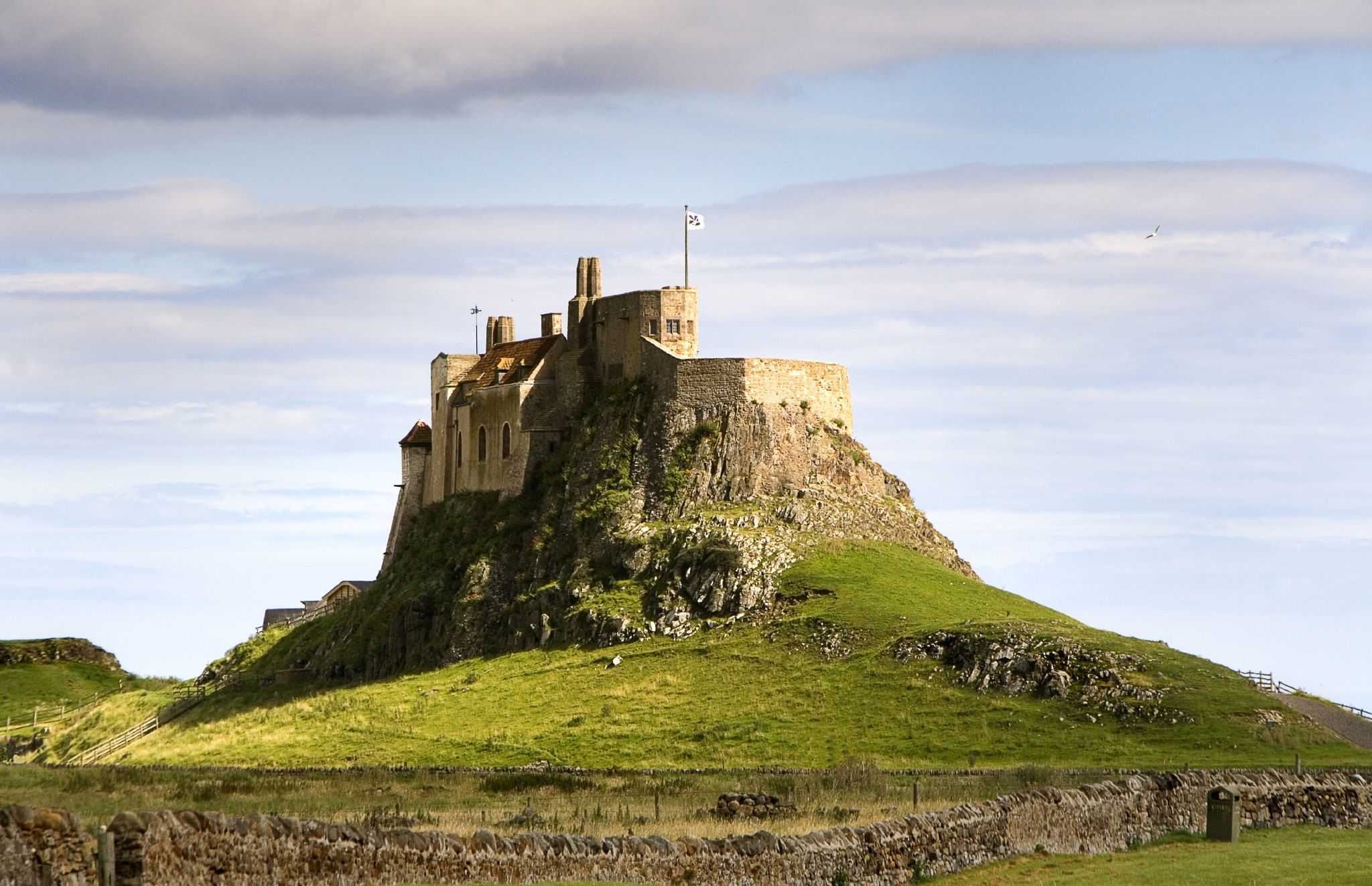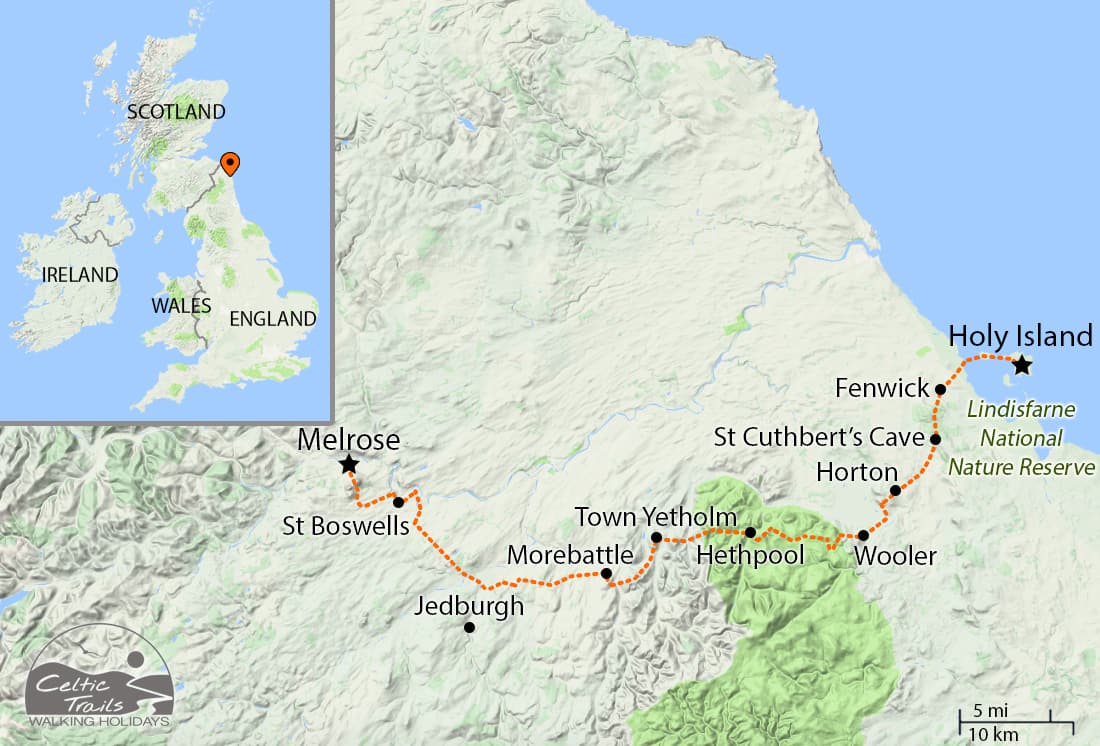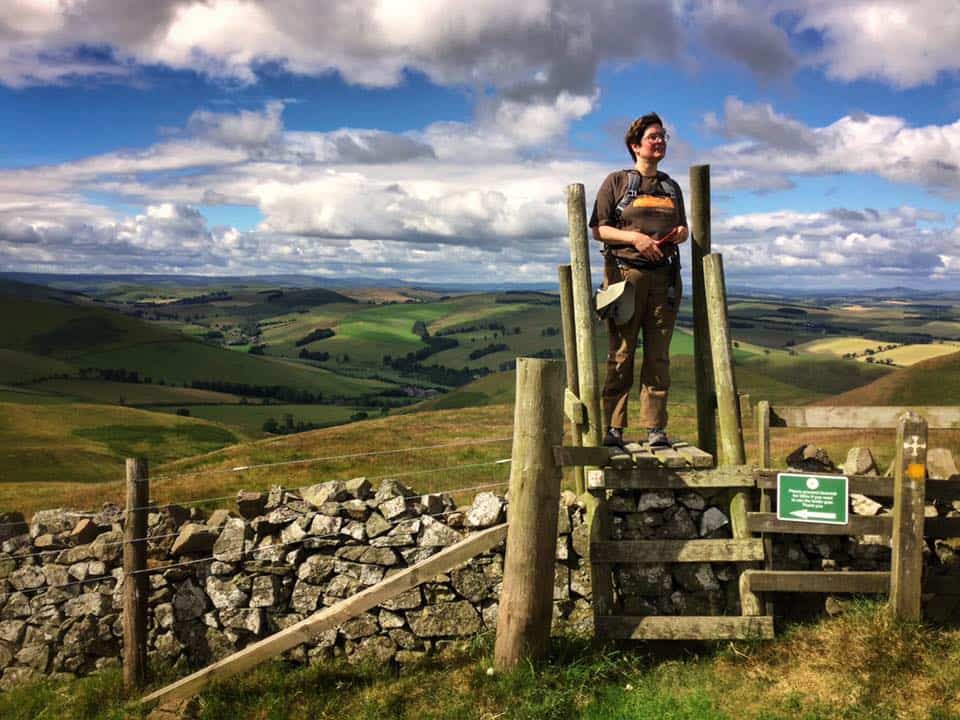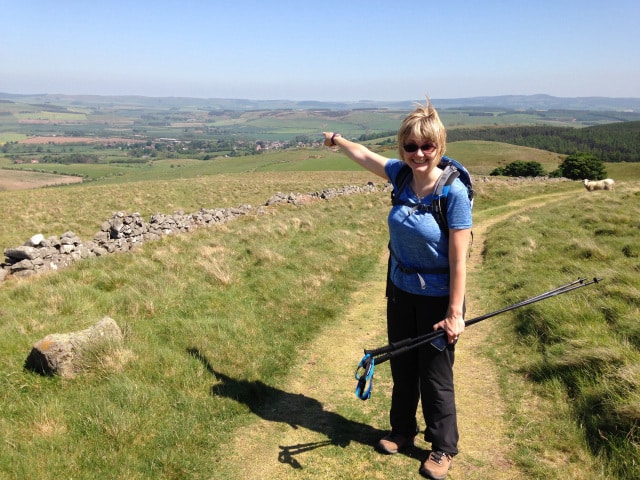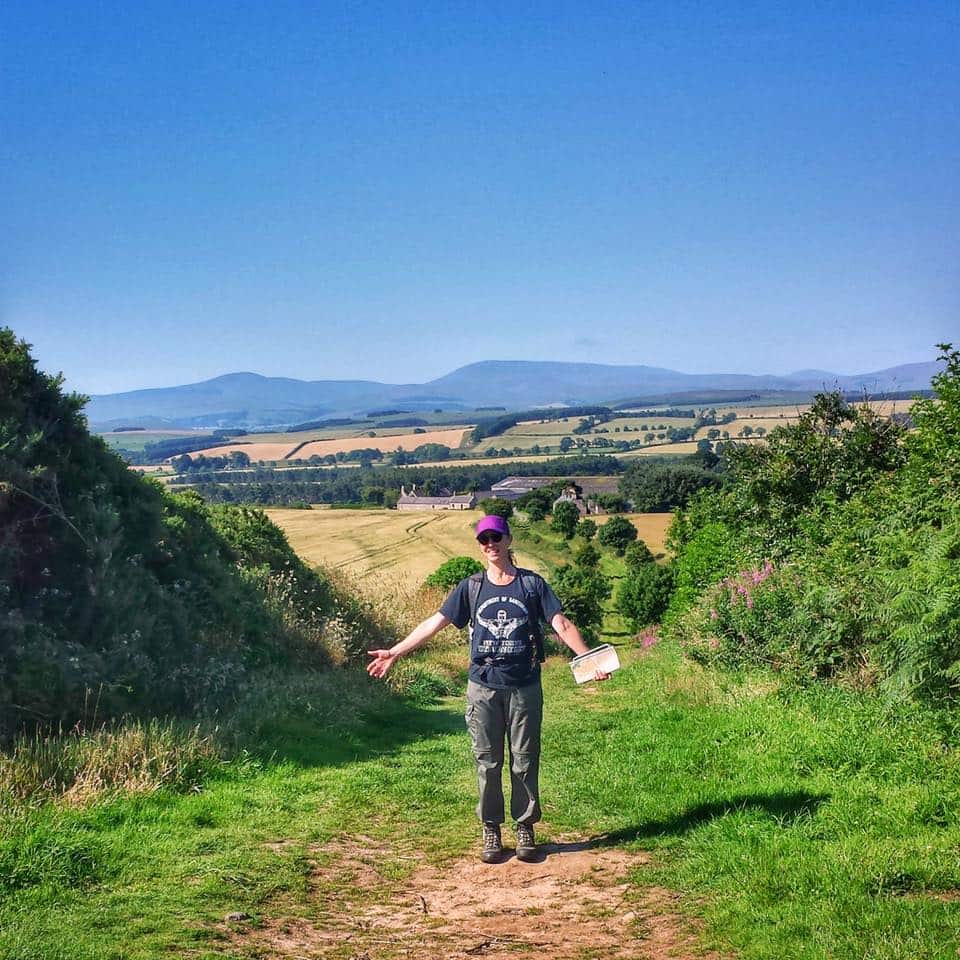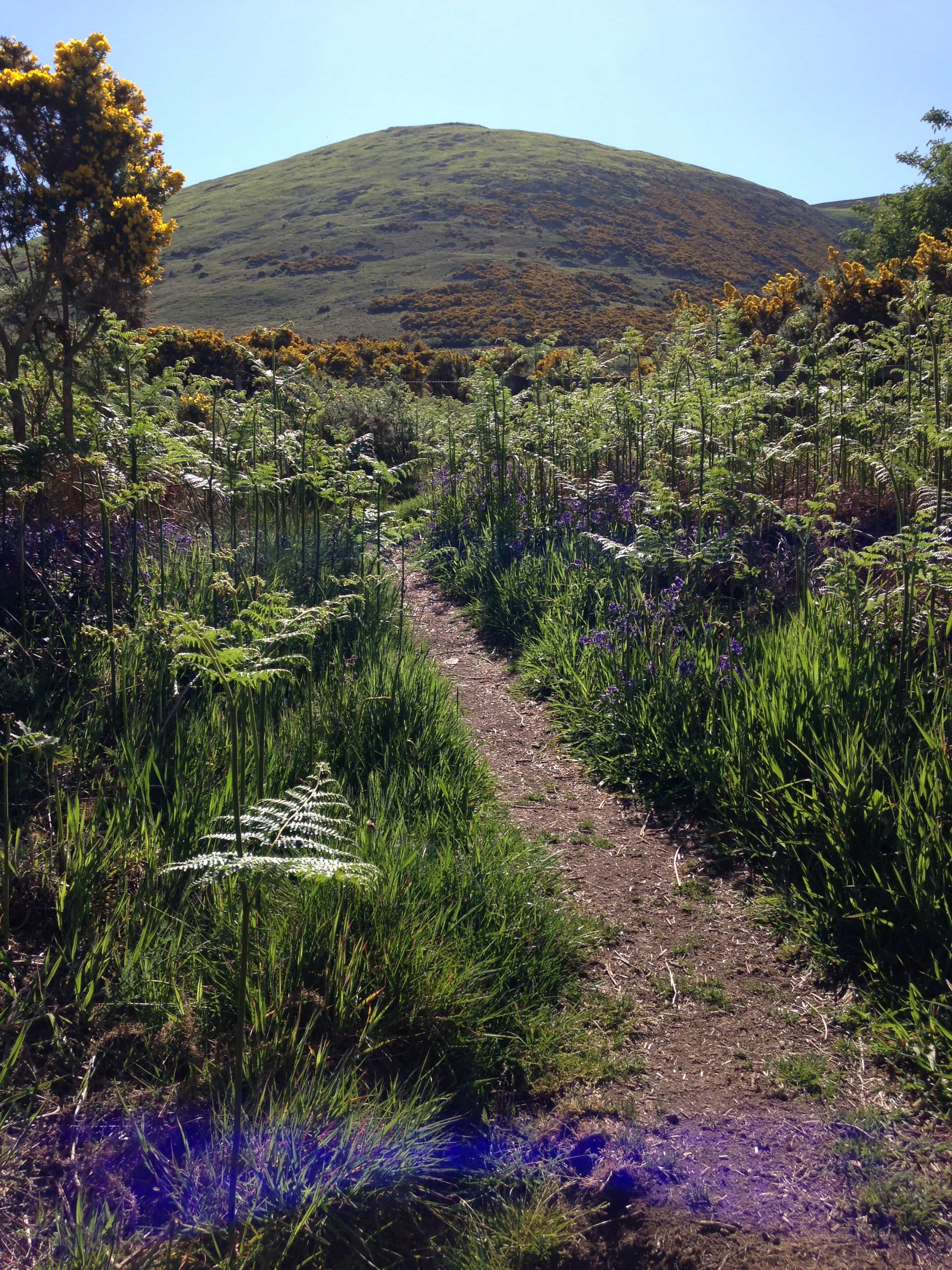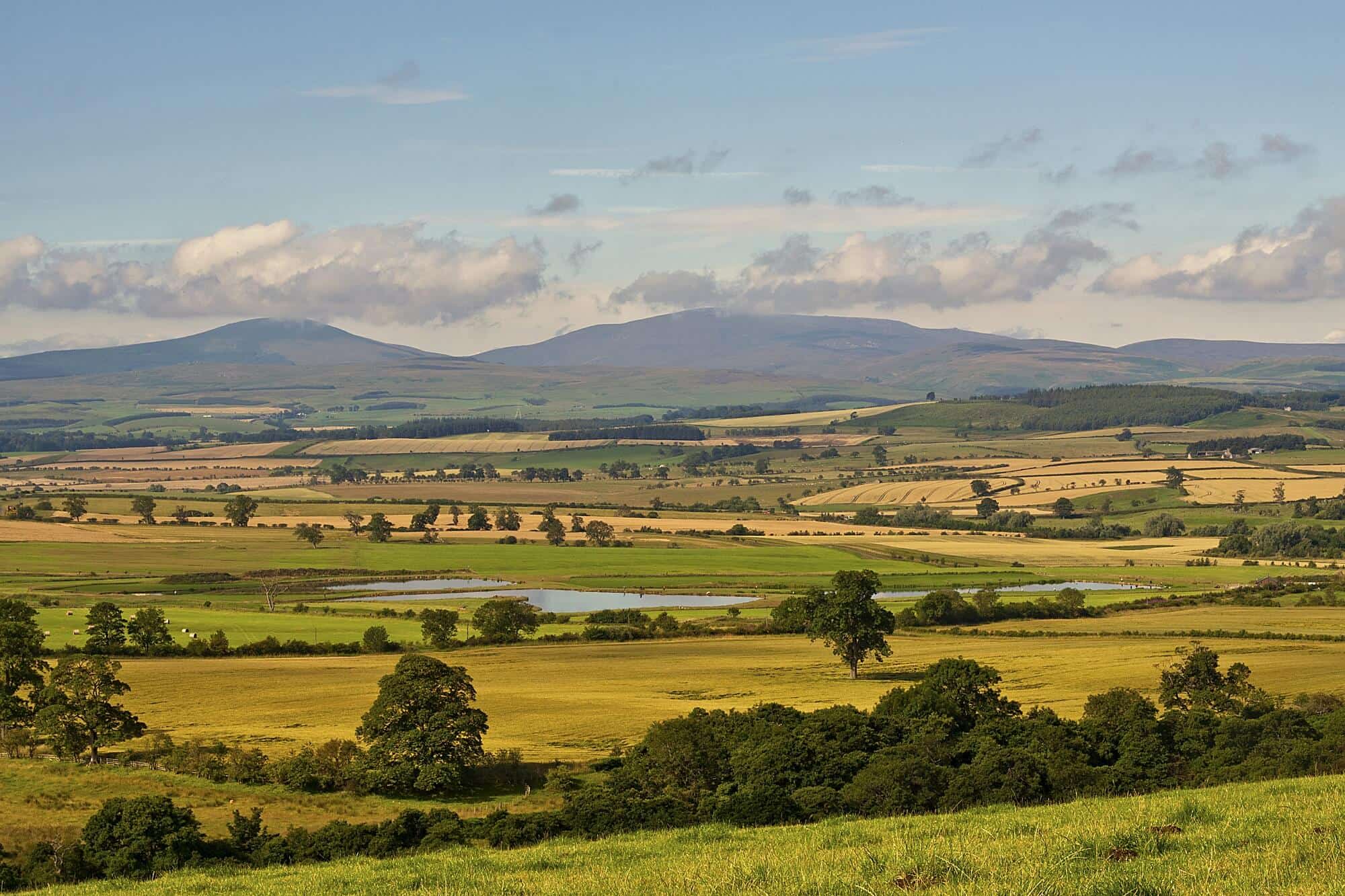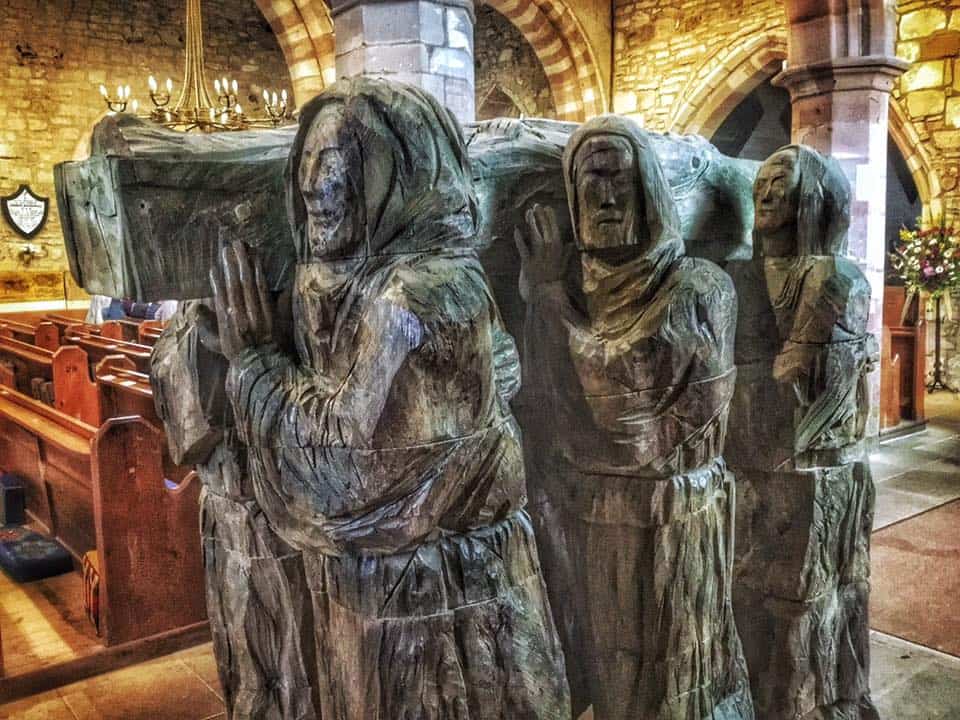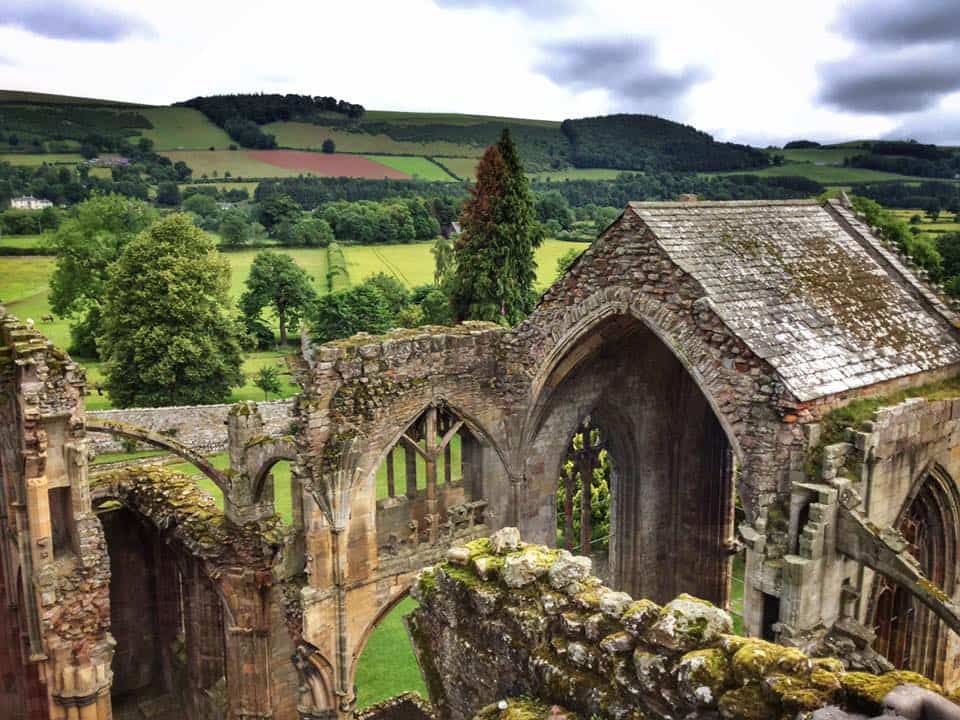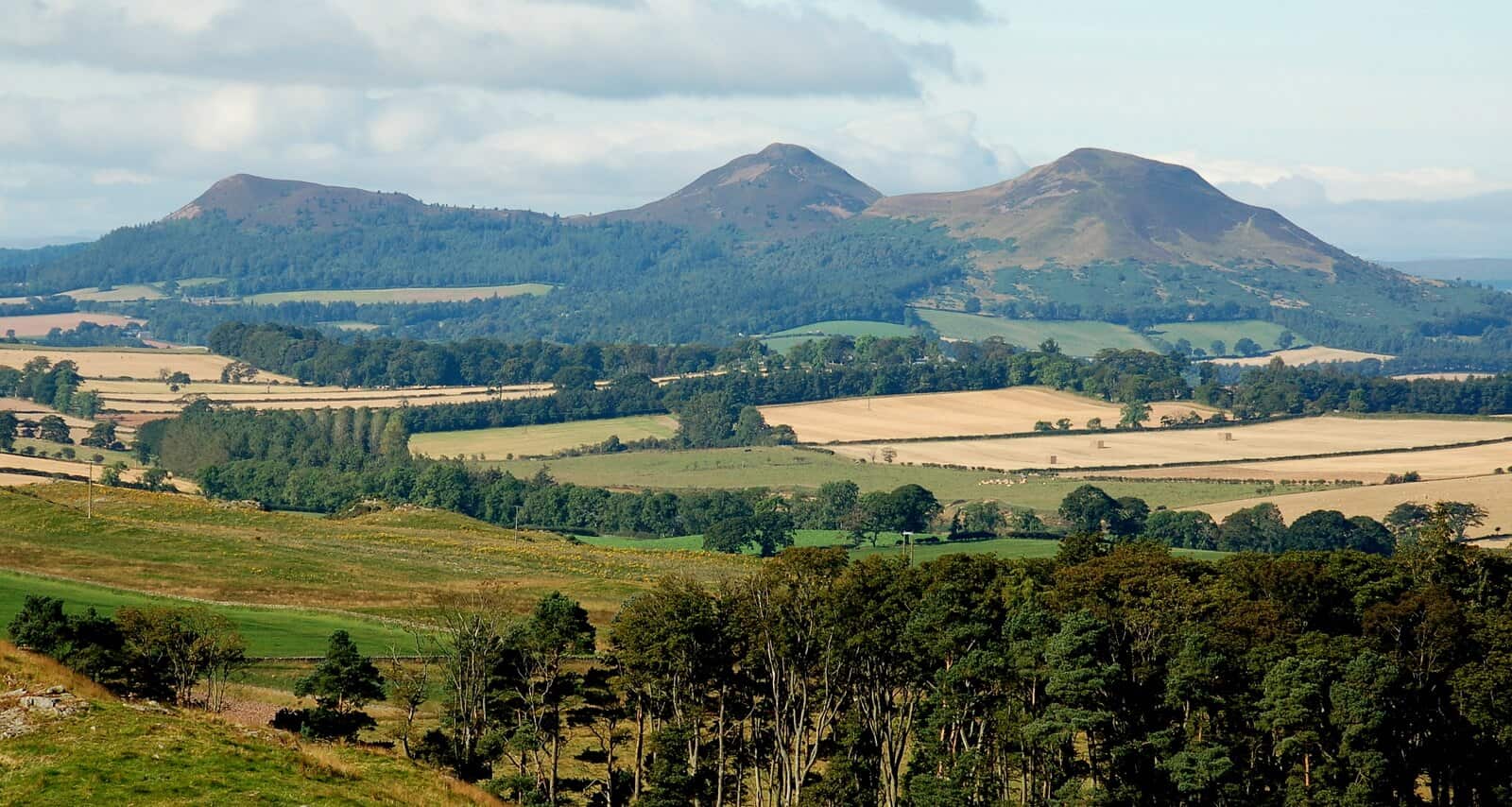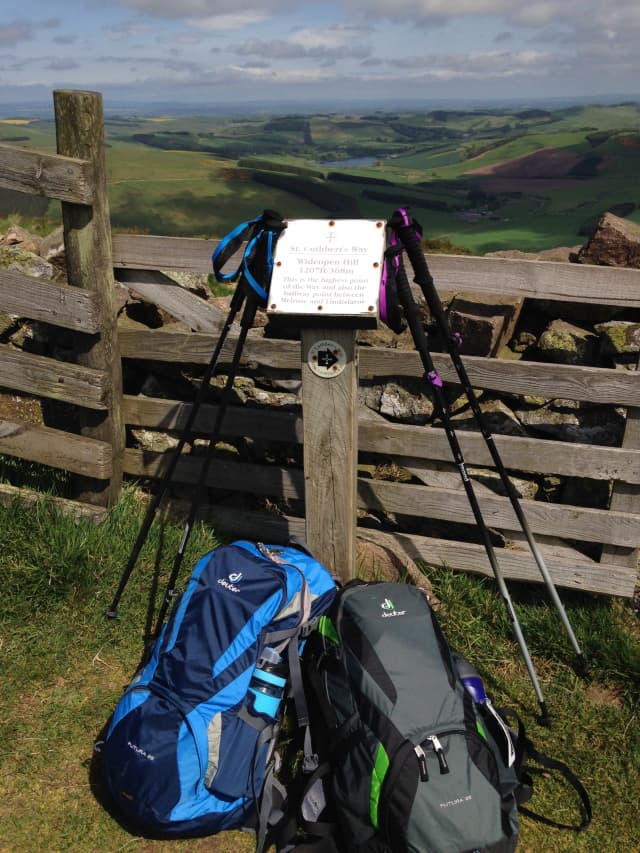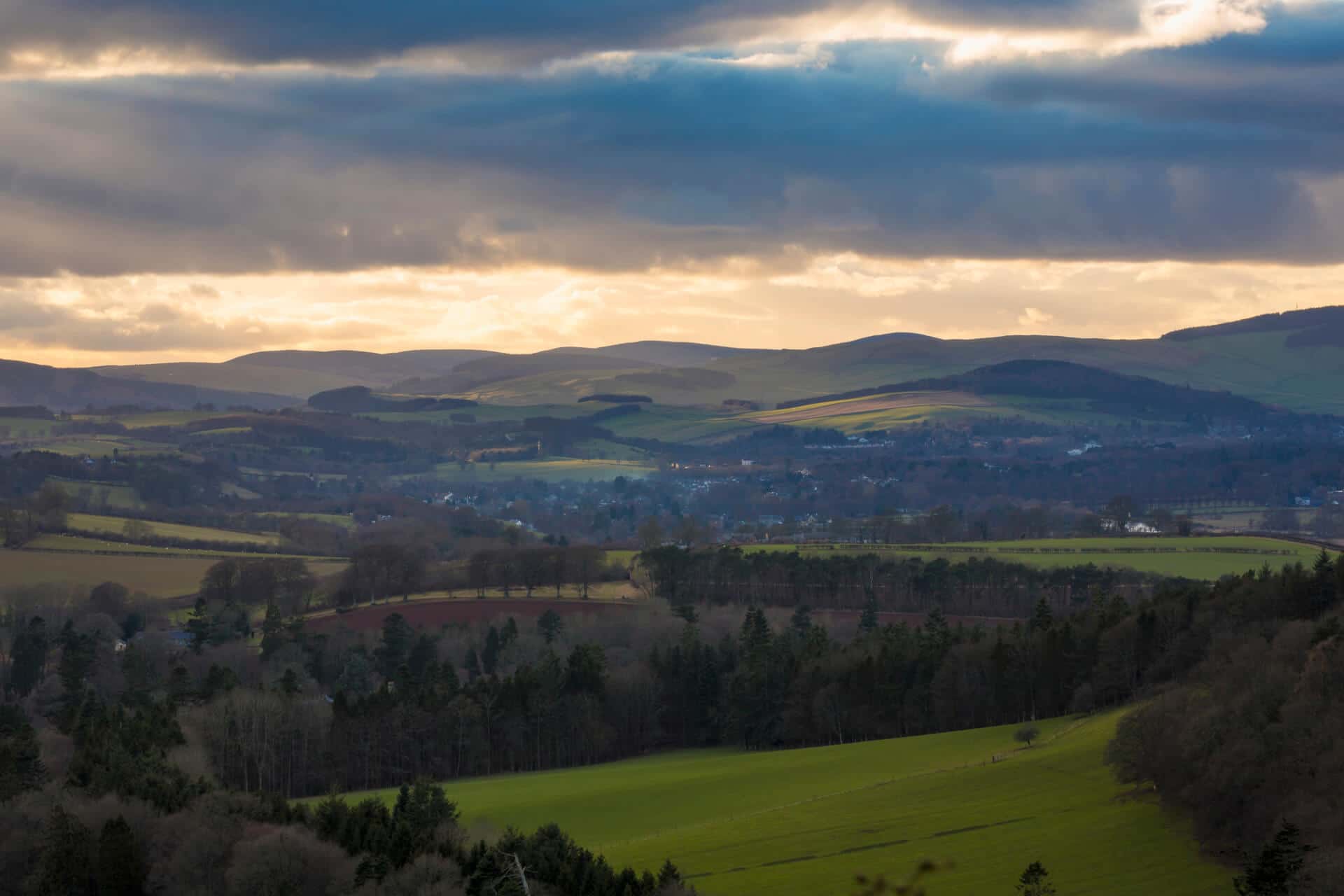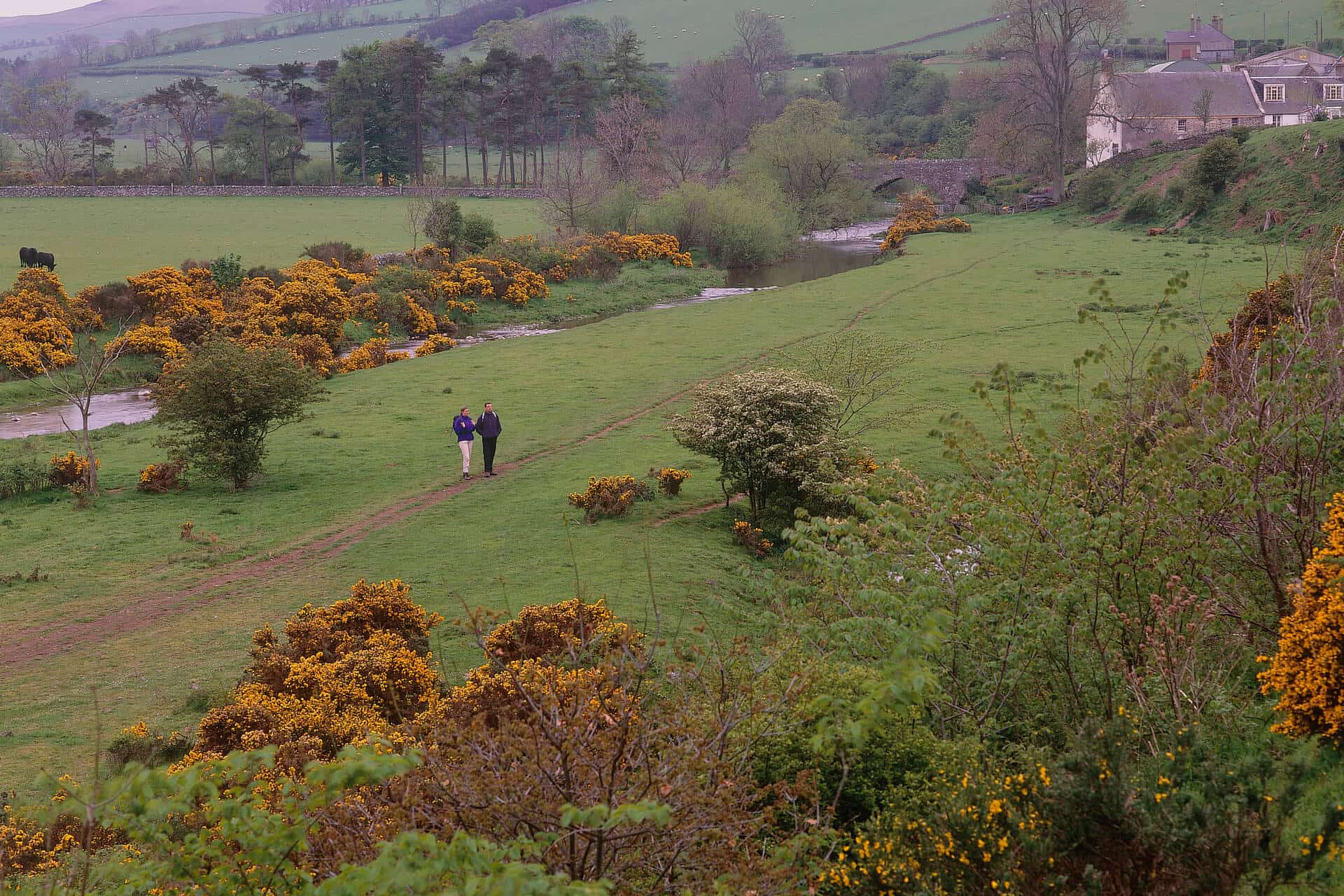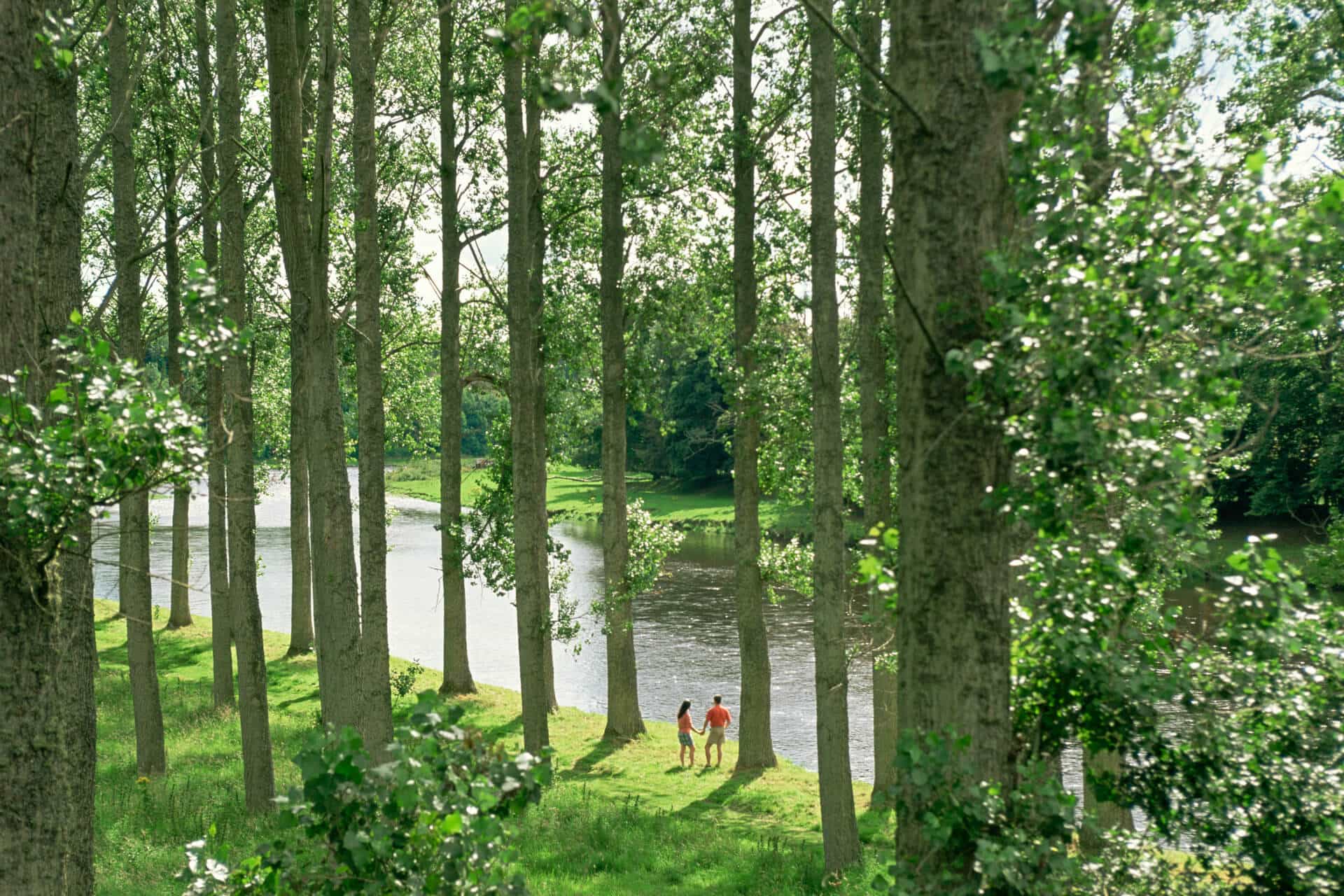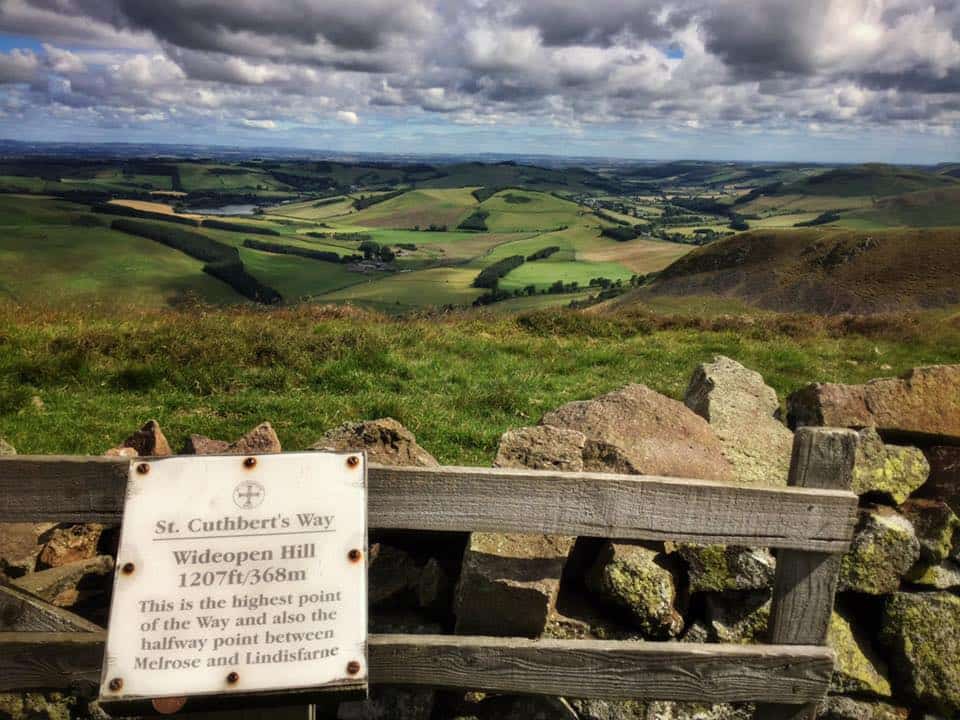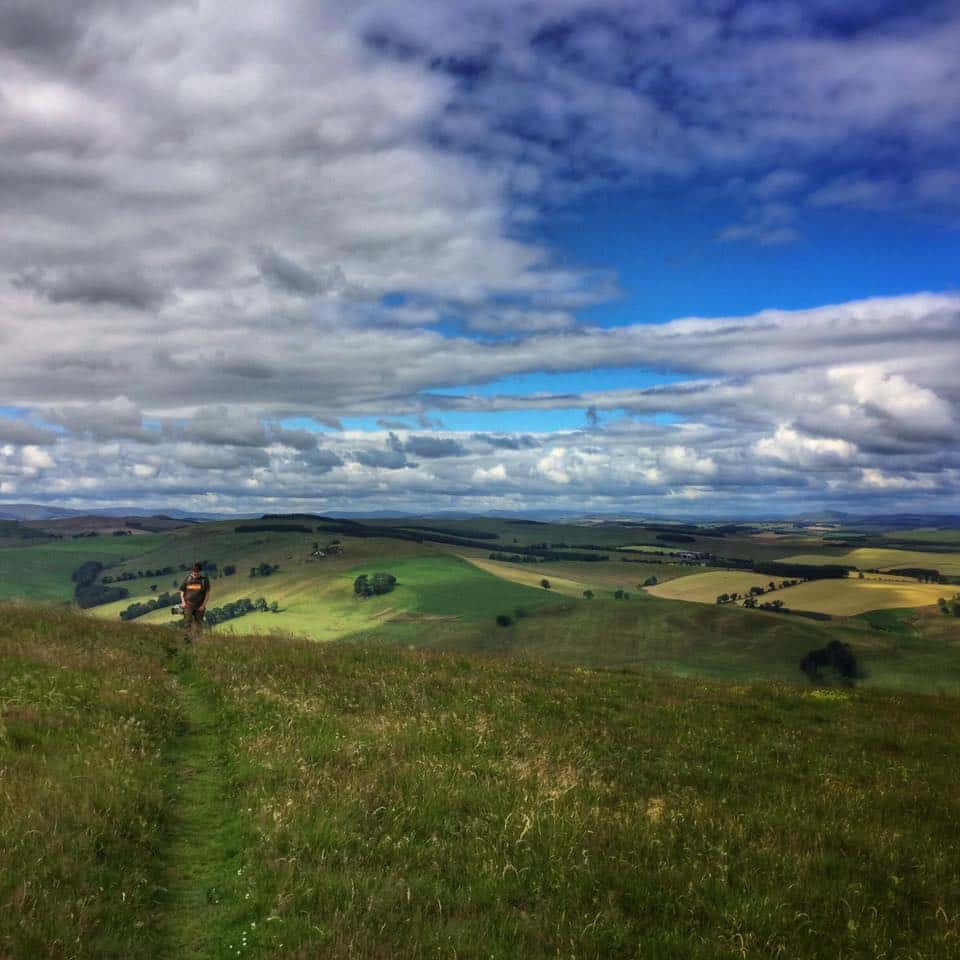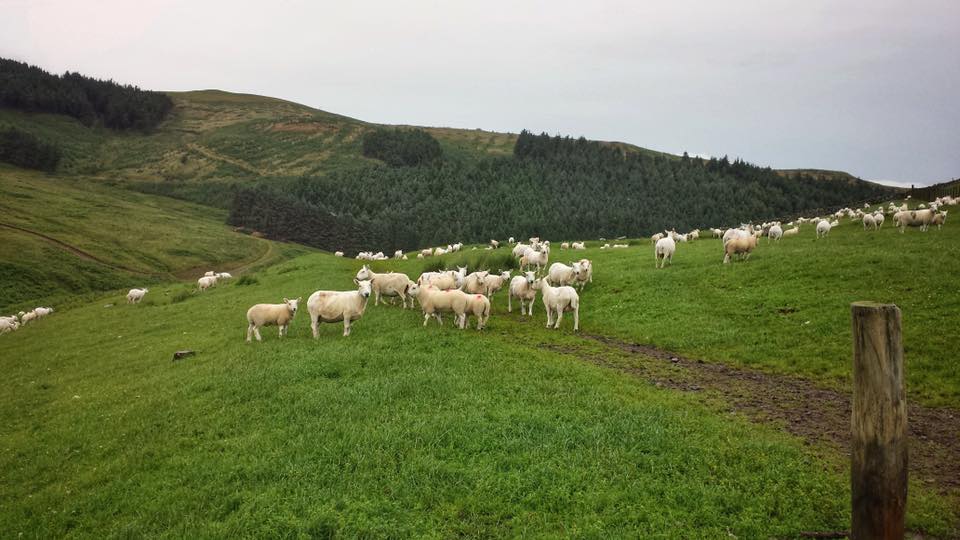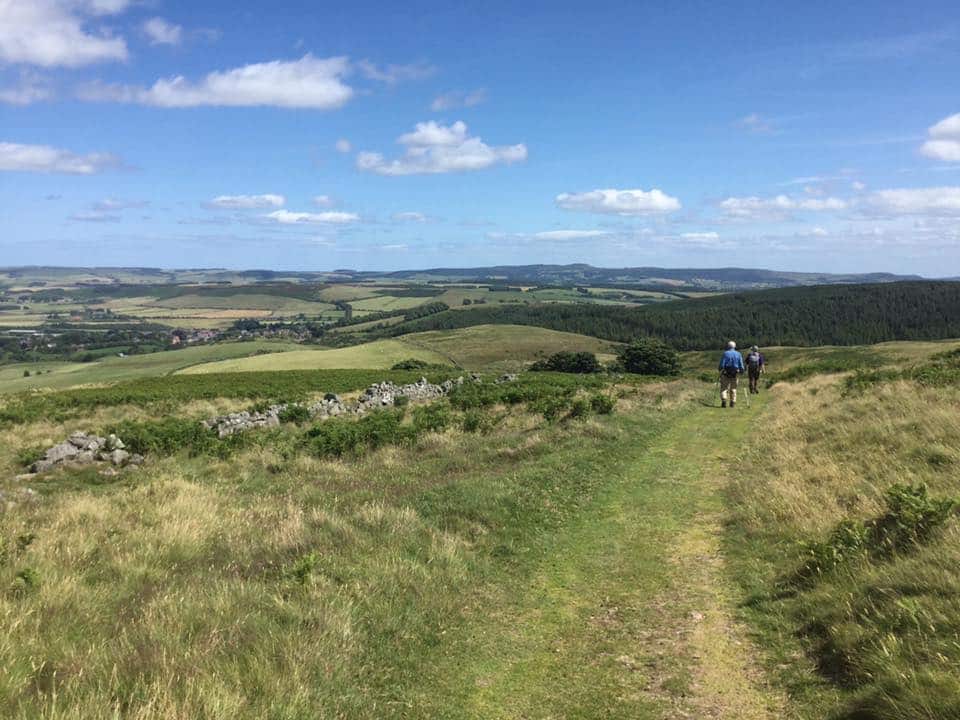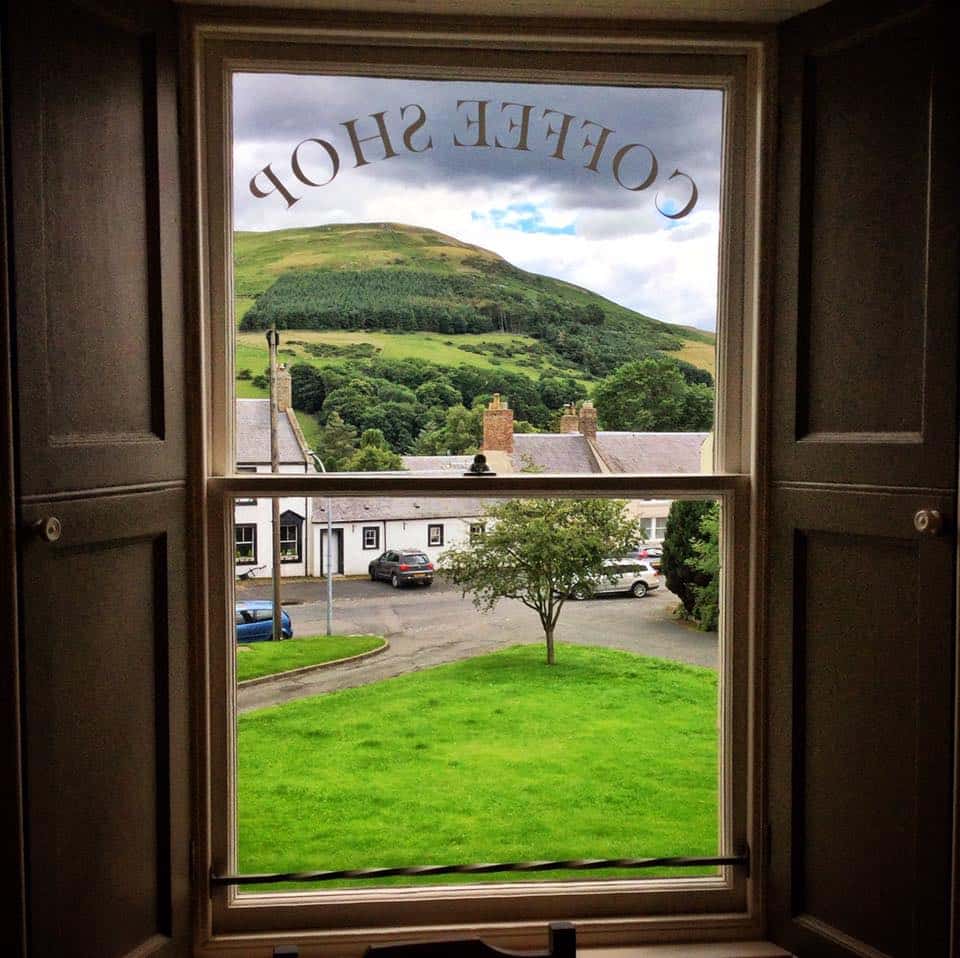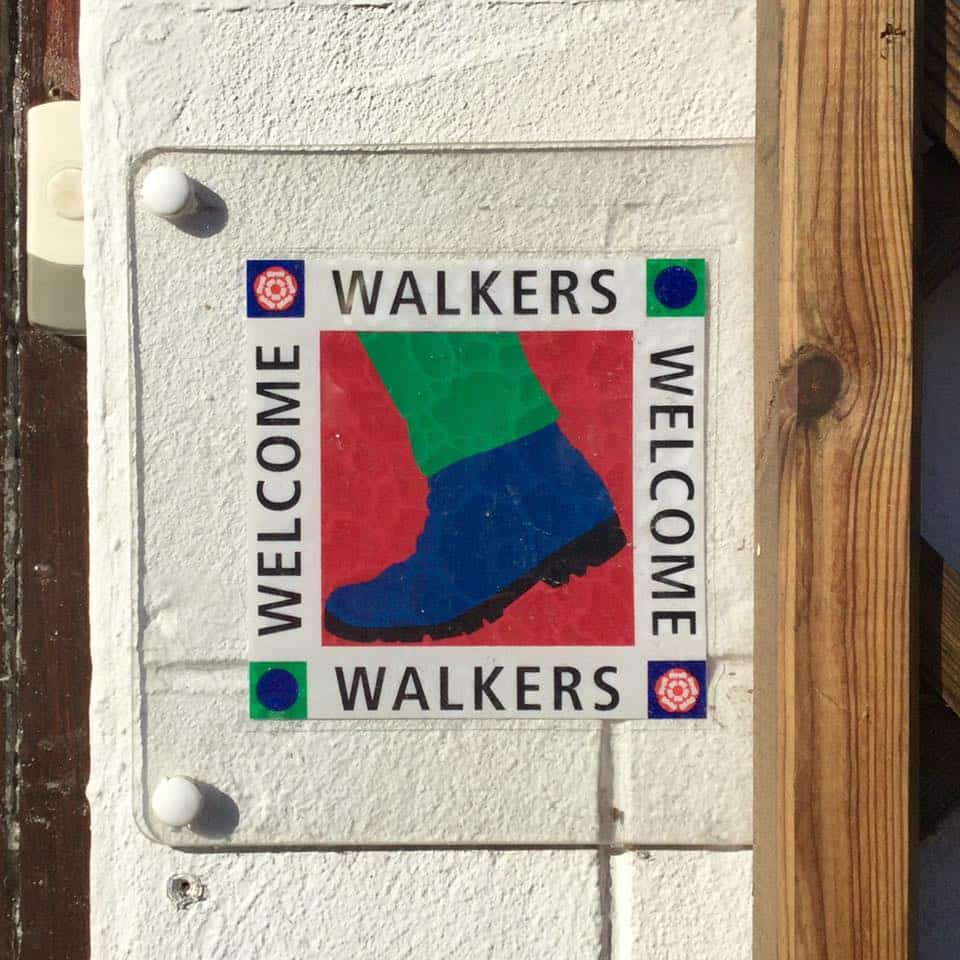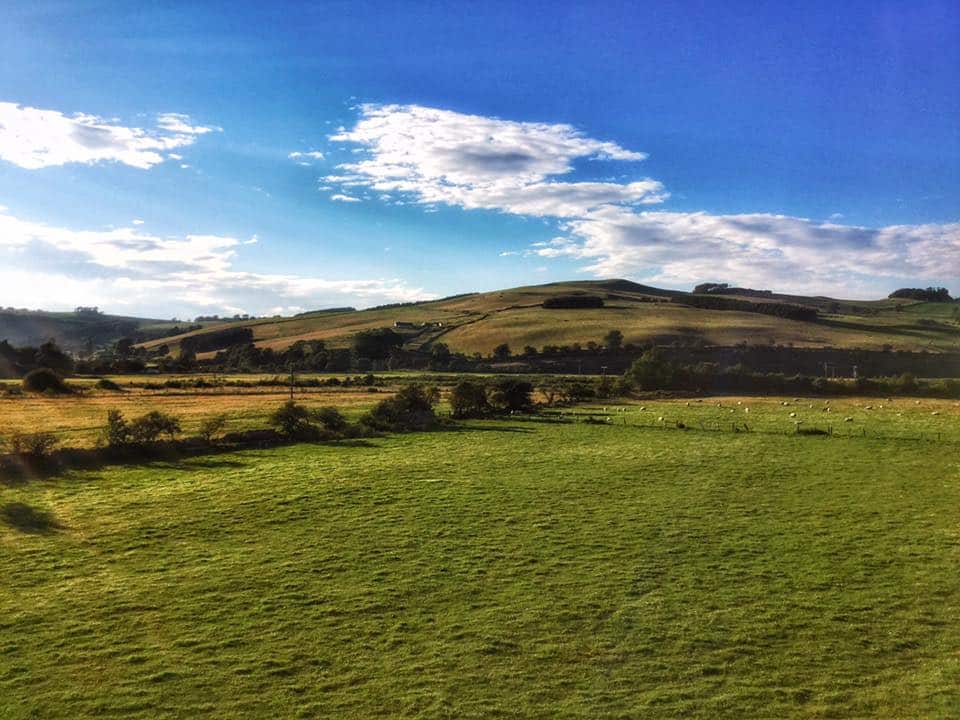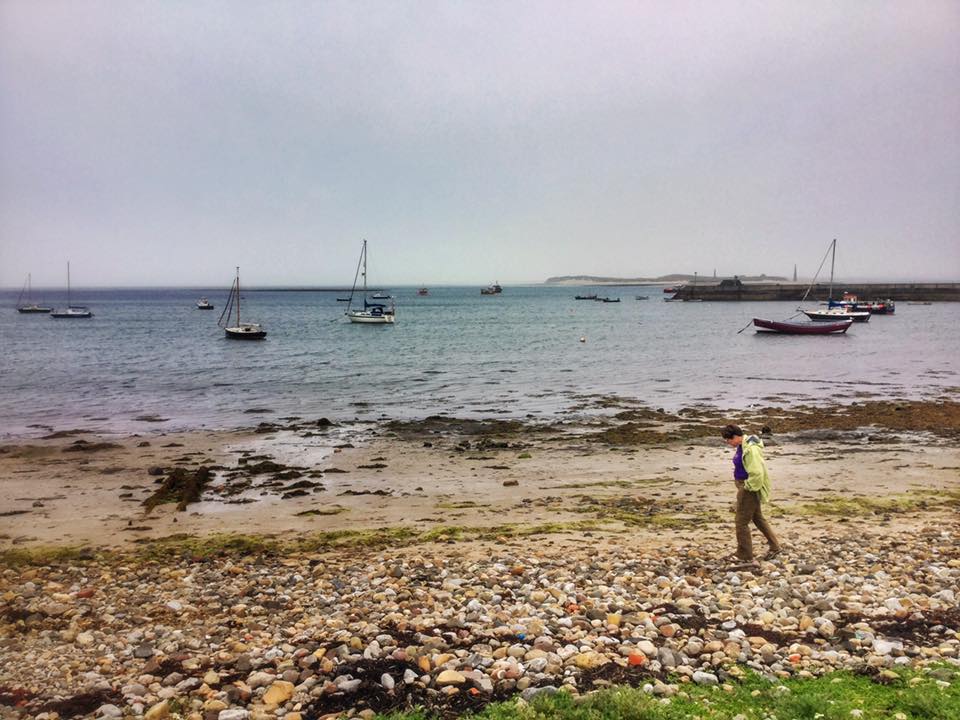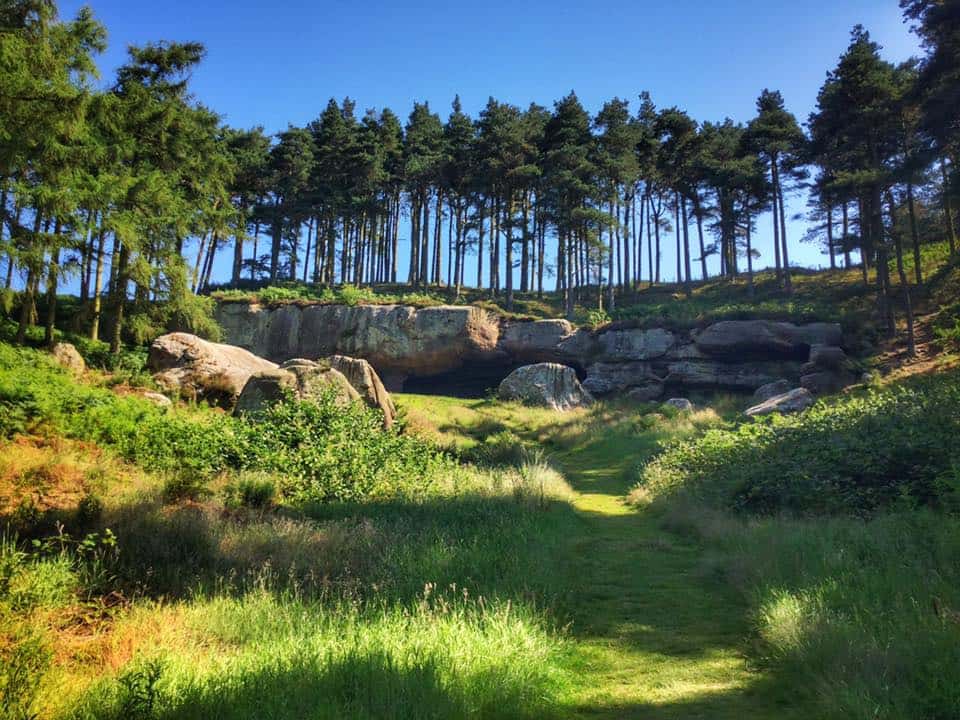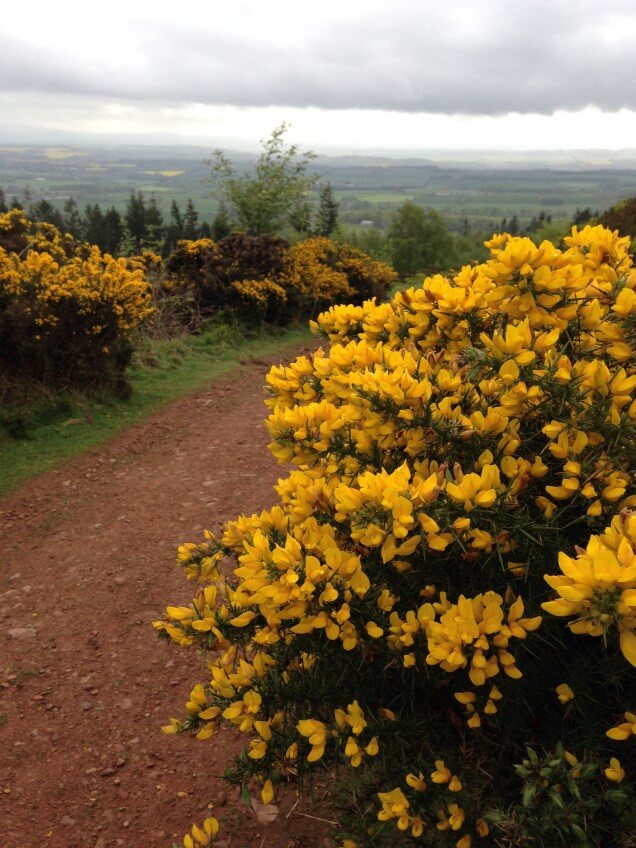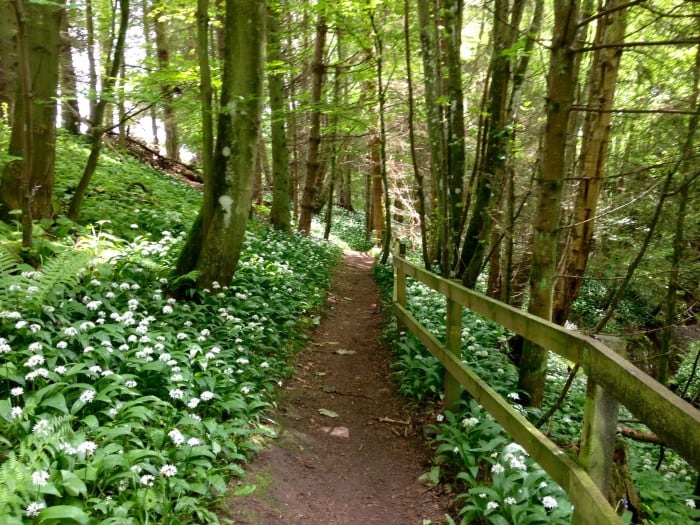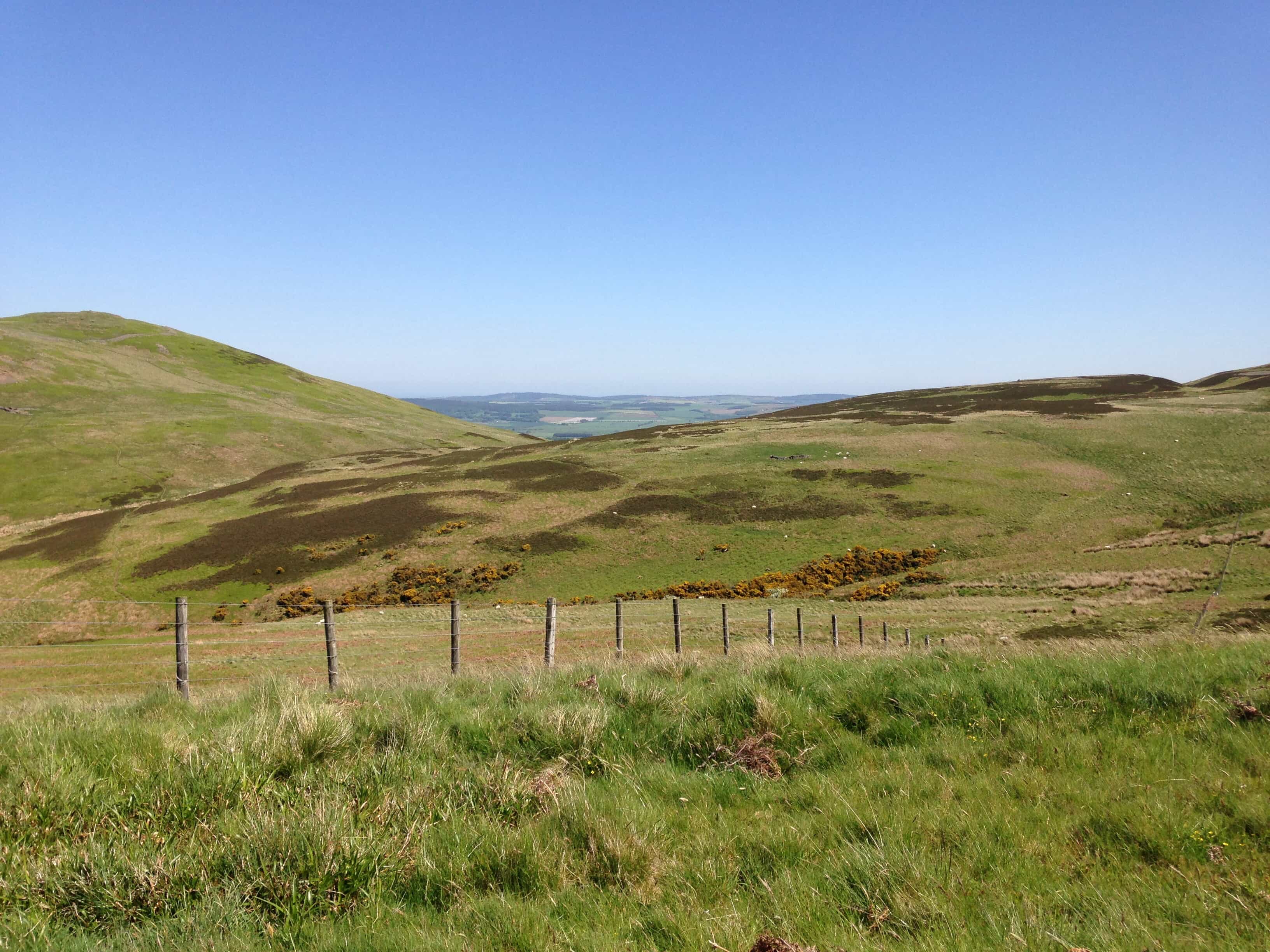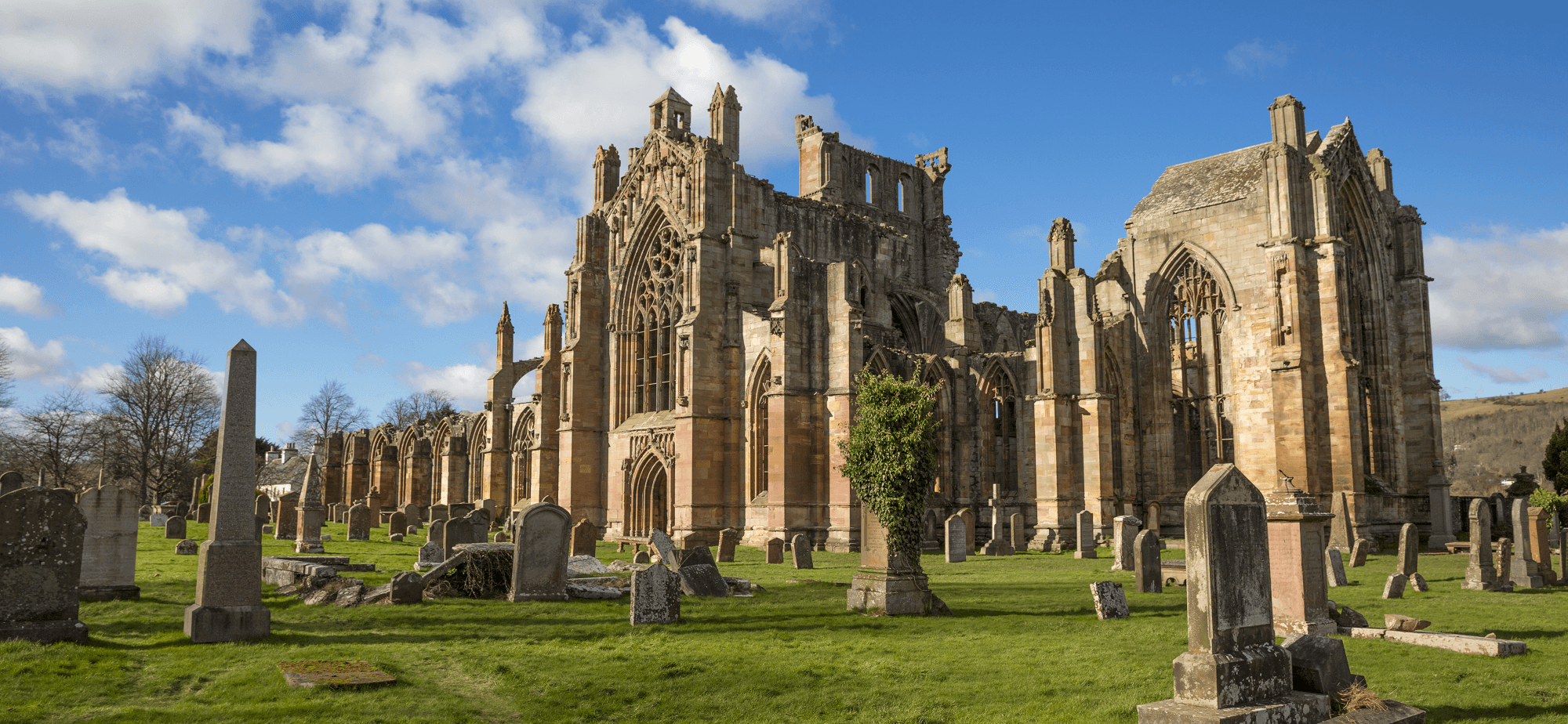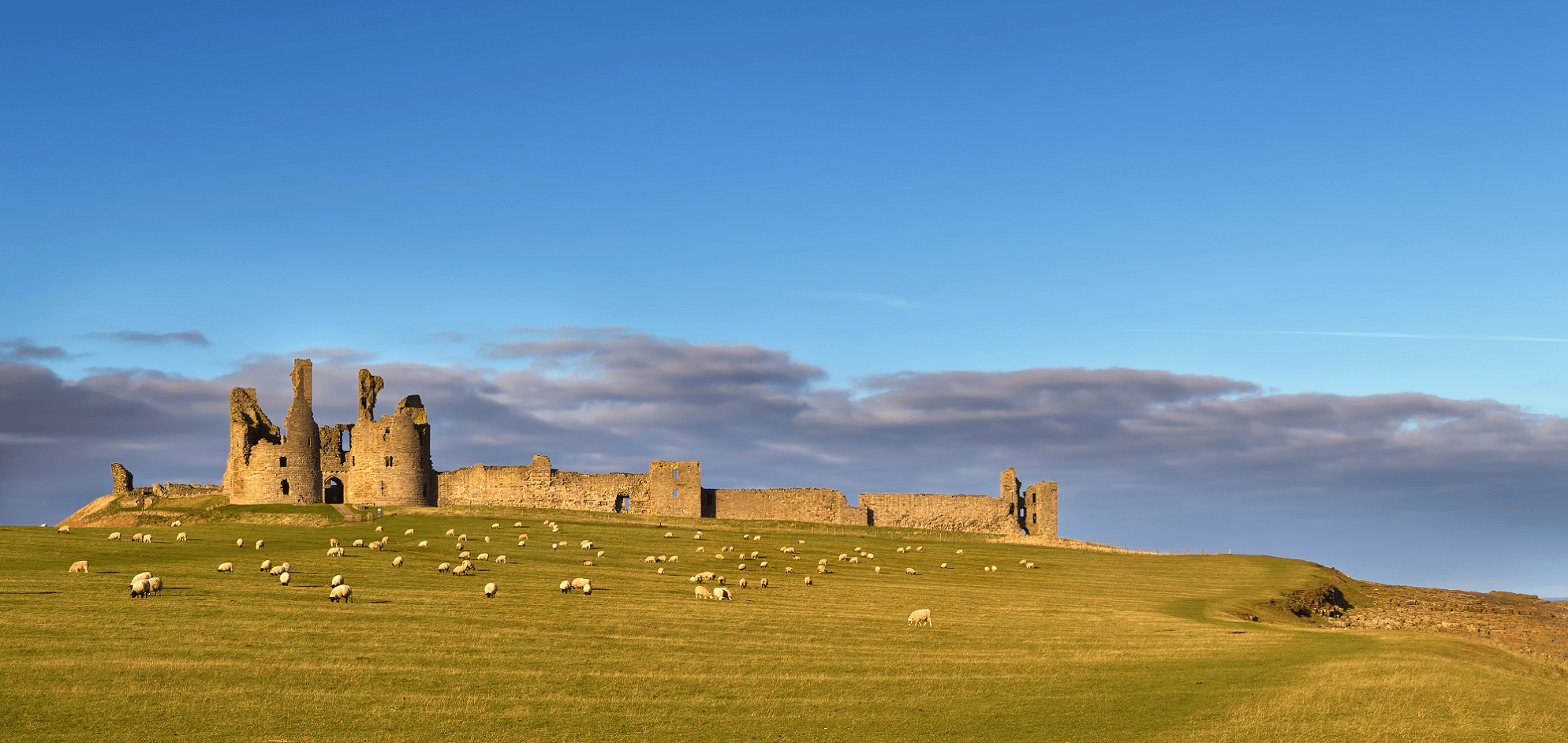St. Cuthbert’s Way Walking Holidays
- Ruins of Dryburgh Abbey
- Exploring the market towns of Jedburgh and Wooler
- The war-scarred remains of Cessford Castle, part of many flashpoints along the border in the Anglo-Scottish wars
- The scenic village of Kirk Yetholm
- St. Cuthbert’s Cave in the Kyloe Hills – the site where monks hid St. Cuthbert’s body when they fled Lindisfarne to escape the Vikings
- Crossing the tidal causeway to Lindisfarne
- Touring the ruined abbey and spectacular castle on the Holy Island of Lindisfarne
Walking St. Cuthbert’s Way
Follow St. Cuthbert's Way through the pastoral route taken by St. Cuthbert, who spread the Gospel through Scotland and northern England in the 7th century. Cuthbert started his ministry in Melrose in about 650AD. He later became Prior and eventually Bishop of Lindisfarne (Holy Island) where he died in 696AD. His remains were taken from the island in 875AD after Viking raids. He was eventually laid to rest within a loop of the River Wear, subsequently becoming the site for the magnificent Durham Cathedral.
The St. Cuthbert’s Way walk begins in the quaint Borders town of Melrose with its magnificent 12th century Cistercian abbey. Our trail leads us over the Eildon Hills, blanketed in heather and offering spectacular panoramic views to the border country, to where we find the delightful village of Bowden.
The path follows the River Tweed, where St. Cuthbert’s Way encompasses the splendid ruin of Dryburgh Abbey. Leaving the Tweed to follow the Roman road of Dere Street and cross the River Teviot near Jedburgh, we come across a borders market town boasting yet another historic abbey. You continue to the towering Cessford Castle one of several spectacular sites en route to the village of Kirk Yetholm, nestling beneath the Cheviot Hills.
You now cross the Scottish border, over the magnificent Cheviot Hills to the market town of Wooler. Your route leads to St. Cuthbert’s Cave in the Kyloe Hills, which sits on a dramatic sandstone overhang. This is reputedly where monks hid St. Cuthbert’s body when they fled Lindisfarne to escape the Vikings.
The final leg of St. Cuthbert’s Way moves down to cross the tidal causeway (at an appropriate low tide) and leads on to your journey’s end at the Holy Island of Lindisfarne, where the ruined abbey and spectacular castle complete a magnificent journey through centuries of ancient Scots-English heritage.
Path Walkthrough
The trail itself is not heavily used, so the route is not always clearly defined. However, every turn-off junction is waymarked with a St. Cuthbert's Way signpost, linking with The Border Abbey and St Oswald's Way on occasion. St. Cuthbert's Way has been graded 'Moderate' in terms of difficulty, however our SCW1 would make a great introduction to long distance walking. The first two sections of the SCW2 itinerary cover 25 miles over two days, our SCW2 itinerary adds another day to break up the walk into something more manageable.
Walking the St. Cuthbert's Way shouldn't prove too challenging, however there are steep and sometimes boggy sections where the going is a little harder - particularly between Kirk Yethholm and Wooler. With the exception of a few infrequent climbs the trail is fairly level, with prolonged walking uphill on this route bringing you to some of the most memorable views over the Eildon Hills.
Our St Cuthbert’s Way Itineraries
 Melrose to Lindisfarne (Holy Island)
Melrose to Lindisfarne (Holy Island)
Distance: 62 miles (99.5km)
SCW1
8 Nights
from £985
SCW2
7 Nights
from £870
 Melrose to Lindisfarne (Holy Island)
Melrose to Lindisfarne (Holy Island)
7 nights, 6 days
| Day | Walk | Distance | |
|---|---|---|---|
| Day 1 | Arrive Melrose | 1n | |
| Day 2 | Melrose to Harestanes (t) | 15.5 mls | 1n |
| Day 3 | (t) Harestanes to Morebattle (t) | 10 mls | 2n |
| Day 4 | (t) Morebattle to Kirk Yetholm | 6.5 mls | |
| Day 5 | Kirk Yetholm to Wooler | 13 mls | 1n |
| Day 6 | Wooler to Fenwick | 11.5 mls | 1n |
| Day 7 | Fenwick to Lindisfarne, the Holy Island | 6 mls | 1n |
| Day 8 | Depart Lindisfarne (Holy Island) |
2024 Prices
Itinerary price: £870 per person, based on two people sharing.
Solo walkers supplement: £79 per person per night.
Single occupancy within group: £56 per person per night, for groups of 2 or more people.
Extras
Rest days/additional nights: Prices from £65 per person per night.
We recommend an extra day at the end of your holiday to enjoy the opportunity for a boat trip around the Farne Islands - National Nature Reserve and home to an internationally important breeding colony of thousands of seabirds and grey seals. Alternatively, consider a rest day on Holy Island.
Upgrade options: Speak to our team to discuss upgrade options for this itinerary.
Walk Pack postage: Europe - to first night’s accommodation, Rest of World - £30 supplement, (UK is included in price).
Extra Walk Packs: can be requested, please see here for full details and supplements.
Bank Holidays and short notice bookings may incur extra charges.
SCW3
6 Nights
from £740
 Melrose to Lindisfarne (Holy Island)
Melrose to Lindisfarne (Holy Island)
6 nights, 5 days
| Day | Walk | Distance | |
|---|---|---|---|
| Day 1 | Arrive Melrose | 1n | |
| Day 2 | Melrose to Harestanes (t) | 15.5 mls | 1n |
| Day 3 | (t) Harestanes to Kirk Yetholm | 16.5 mls | 1n |
| Day 4 | Kirk Yetholm to Wooler | 13 mls | 1n |
| Day 5 | Wooler to Fenwick | 11.5 mls | 1n |
| Day 6 | Fenwick to Lindisfarne, the Holy Island | 6 mls | 1n |
| Day 7 | Depart Lindisfarne (Holy Island) |
2024 Prices
Itinerary price: £740 per person, based on two people sharing.
Solo walkers supplement: £81 per person per night.
Single occupancy within group: £56 per person per night, for groups of 2 or more people.
Extras
Rest days/additional nights: Prices from £65 per person per night.
We recommend an extra day at the end of your holiday to enjoy the opportunity for a boat trip around the Farne Islands - National Nature Reserve and home to an internationally important breeding colony of thousands of seabirds and grey seals. Alternatively, consider a rest day on Holy Island.
Upgrade options: Speak to our team to discuss upgrade options for this itinerary.
Walk Pack postage: Europe - to first night’s accommodation, Rest of World - £30 supplement, (UK is included in price).
Extra Walk Packs: can be requested, please see here for full details and supplements.
Bank Holidays and short notice bookings may incur extra charges.
- Good standard accommodation at a mixture of guesthouses, farmhouses, local inns and B&Bs with en-suite or private facilities wherever possible
- Breakfast
- Luggage transfers
- Personal transfer between accommodation and path that form a part of our standard package
- Route planning
- Walk pack including Trail Guide and mapping, itinerary, accommodation directions and route notes, lunch and dinner information, restaurant recommendations and holiday planning details
You choose which day you would like your holiday to start on. We will book your holiday in accordance with your requirements.
Our St Cuthbert’s Way holidays are available to walk March to October.
The best time to visit is between March and October. The way is very unlikely to be crowded at any point of the year, but July and August are the busiest months to visit.
By Rail: There are train stations at Tweedbank and Berwick upon Tweed.
There is rail link between Edinburgh Waverley station to Tweedbank. The station at Tweedbank is served with frequent buses coming into the town of Melrose.
By Bus: A bus from Tweedbank to Melrose takes 9 minutes.
A bus from Berwick upon Tweed to Melrose takes 1 hour 25 minutes.
Taxis:
Lindisfarne to Melrose - prices available upon request.
Lindisfarne to Berwick-upon-Tweed - prices available upon request.
St Cuthbert’s Way Client Reviews
4.8/5 based on 54 reviews
Celtic Trails are very well organized and arranged lovely, comfortable accommodations for us. The St Cuthbert's Way had beautiful scenery with varied walking surfaces.
J. Carder, Victoria BC - May 2024
Left Celtic do all the hard work - they are professional and responsive and will save you a huge amount of time and effort, so you can concentrate on enjoying the trail.
K Jones, Leek - May 2024
Celtic Trails were well organized and thorough with the information provided on all aspects of the trip.
C. Van Erp - May 2024
I had no hassle booking with Celtic Trails and they were very reliable.
Antje, Germany - May 2024
Celtic Trails were very supportive and responsive, instructions and guidance are good and the team are helpful and cheerful.
Anon - May 2024
Smooth, helpful and informative from initial enquiries to the holiday itself
Anon - September 2023
The support from Celtic Trails was excellent. Nathan was knowledgeable about the walk and able to suggest a modification to my rest day requests that ended up being perfect. All emails were responded to promptly and questions answered.
R. Henderson - September 2023
Celtic Trails take away the stress of figuring out the details of your walking holiday, so you can enjoy the experience.
S. Nance - September 2023
This walking holiday was refreshing and restorative. Celtic Trails handled everything very professionally.
R. Simpson - September 2023
One of the best walking companies around; great B&Bs, food and walk organisation. Transfers were prompt and flawless.
Susie Cook - August 2023
Excellent service from a family run business with many, many trips and options from which to choose.
Kay D. - August 2023
I would recommend Celtic Trails, they were very efficient and helpful.
Anon - August 2023
Celtic Trails were well organised and we felt that the walking distances for St Cuthbert's Way were sensible.
Anon - August 2023
Very professional & efficient. Excellent communication prior to starting our holiday. Celtic trails are spoken highly of by places we stayed at.
Liz Brighton - July 2023
Celtic Trails are a reliable company for trail walks. I enjoy the sense of achievement going from A to B. Impressive Abbeys. highlights were the hills from Morebattle to Yetholme and Wooker.
Gill, London - May 2023
It is such a wonderful way to spend a holiday - relaxing, yet challenging; mediative, yet social (loved meeting other walkers).
Carla Nielsen - May 2023
Celtic Trails are thorough and personal. We had some changes to make en route and they helped us. I thoroughly enjoyed this hike. The people ie locals and travellers and hosts alike were wonderful. The history ie the abbeys and the story of St Cuthberts made the walk much more than and walk. Especially wading through the water on the tidal flat to Holy Island. The scotch was also good!
Sheila Mitchell Lenes - May 2023
Celtic Trails are reliable and trustworthy. Much better than other companies. It is a great sense of adventure and achievement to do long distance walks. Especially great when there?s also a sense of history and places like St. Cuthberts.
Susan, Australia - April 2023
This walk has shown that at 81 years it is still possible to walk 100 km in seven days and feel good, both physically and mentally afterwards. Celtic Trails were Thorough, accurate and friendly.
kmath - April 2023
Just a lovely experience. Great to know a bed was booked and clean clothes would be there on arrival. We went as a pilgrimage - it was hugely beneficial to our health and well-being, especially in Holy Week with appropriate readings.
Anon - April 2023
Our experience with Celtic Trails was excellent. As always, great, cheerful assistance from Nathan. Great value for money. We would, and do, recommend Celtic Trails to others. All of the proprietors rave about Nathan and how great it is to work with him. St. Cuthbert's Way was even better than we expected. Beautiful scenery, great abbeys.
Stephen Saunders, Austin, Texas - March 2023
Our experience was AMAZING! Your website doesn't convey just how incredible the walk was, but maybe that is not possible. Great transfers! Nice drivers! Celtic Trails were easy to deal with and professional. We would absolutely recommend. I would do any of your UK walks, but The Wye Valley and Dingle Way have been particularly recommended. I most enjoyed the freedom. All I had to do each day was get up and walk. It was wonderful.
Anon - March 2023
Our experience with Celtic Trails was easy and kind. The weather and birdwatching were perfect.
Anon - October 2022
St. Cuthbert's is a really good walk, because it can be down within a week, with travel. Really good mix of countryside contrasts. Our experience with Celtic Trails was hassle free, with decent accommodation. Better than other companies. Book early to g
Tim and Julie, East Midlands - September 2022
Celtic Trails planned our holiday in meticulous detail, and everything worked. Walking to Holy Island through the sands and the roaring of about 200 seals at low tide was a fantastic ending to the walk.
Dylan, Shropshire - August 2022
I'd enjoy doing another walk someday if God permits. I'd probably see if you could support it. Thanks for your work for me.
Rod Cossgrove - June 2022
Dealing with Nathan was a particular pleasure; he recommended this walking route to us after learning more about our past experiences and wishes for the trip. We hadn't previously heard of the route and it turned out to be ideal. We also really apprecia
Jenny, Toronto - May 2022
Celtic Trails were well organised; this was a lovely walk - a pilgrimage to a holy place. Nice friendly hosts.
Dick & Nita - May 2022
Celtic Trails has every detail planned and ensured a smooth and stress-free experience. If any problems arise, there is a contact number to immediately fix the issue. This holiday had a dramatic physical and mental improvement on our well-being. For a f
Huebert Family - March 2022
Celtic Trails' organisation made the walk very comfortable - no worry about finding accommodation. Taxis very good. Everyone was very friendly.
Anon - September 2021
Celtic Trails were great. A very enjoyable walk.
Anon - September 2021
Celtic Trails are very well organised; excellent information, efficient.
Garry, Bedfordshire - September 2021
Really excellent service, start to finish - thank you for really terrific service, Nathan! Thorough, prompt and efficient throughout.
David French, Dorset - September 2021
Celtic Trails was the first walking company I have booked with. They were first class. Professional. Patient. Impressive attention to detail. Excellent communication. Excellent value. It was a magical experience - good for the soul. Being with nature is the best medicine. St. Cuthbert's Way was a wonderfully varied walk - woodland, farmland, high ridge moors, coast, wonderful history, lovely towns and villages. Thank you for all your help! I have Glyndwr's Way already booked for August.
Veneta - June 2021
Efficient and friendly service. Good accommodation.
David and Liz - Wirral - June 2021
A fab holiday! Brilliant organisation, lovely B&Bs, couldn't have been better. I would definitely recommend Celtic Trails to others. I enjoyed all of this walk. Beautiful countryside well marked route and very varied landscapes.
Anon - June 2021
Flawless organisation, clear communication, excellent accommodation and very good suggestions for where to eat at each stop. This was pure delight. Easy walking, friendly people and beautiful countryside. Walking across the sand to Holy Island was a high point.
Anon - June 2021
Celtic Trails were very organised. This holiday gave me a sense of achievement and an increase in stamina. I'd like to do the West Highland Way, Dales Way and Pembrokeshire Coast next.
Anon - October 2020
Celtic Trails are the best - much better than other companies. This walk was just what I needed. Thanks Ben, you did us proud - really enjoyed the walk.
Jamie - September 2020
I would describe Celtic Trails as efficient - it felt like someone was there in the background, just in case. They took all the effort away, so I could just do the fun part.
J. Jacobs - August 2019
I have always enjoyed long-distance trails and my husband is now developing a love of them as well. St. Cuthbert's was the most beautiful trail I have ever done. There is quite a lot of road walking in Northumberland, but the views are still amazing. A very good experience - our accommodations being exceptionally good in some places.
Murton - July 2019
The personnel at Celtic Trails are knowledgeable, patient, prompt and friendly; they should great attention to detail and care for their customers. The scenery was beautiful. We enjoyed the lovely villages and found our hosts, local inhabitants and other walkers to be quite friendly, pleasant and helpful.
W. Edmonds - May 2019
Everything was very clear and went exactly as planned. We are feeling accomplished and stronger and hope we've inspired friends and family to do a walking holiday of their own. St. Cuthbert's Way was an excellent choice for our first long-distance walk. There were enough others making the walk to feel comfortable and we enjoyed meeting up with them for drinks and meals and the end of each day.
K&M Fairweather - May 2019
St. Cuthbert's Way is one of the best - some tough bits but a wonderful cross-section of country.
Charles - May 2019
I like the personal contact with those organising the trips and the better standard of accommodation.
C.B. - May 2019
We had a fabulous holidays - all went smoothly. Cannot recommend St. Cuthbert's Way highly enough. We've used Celtic Trails four times before and will be using you again - we have already recommended you to friends.
S&J - September 2018
"Really enjoyed St. Cuthbert's Way, very good walks, lots of different types of habitat to walk through, real pleasure".
Maskrey - June 2018
Really enjoyed St. Cuthbert's Way - very good walk, lots of very different types o habitat to walk through. A real pleasure. Thank you Celtic Trails for a great walk.
M - June 2018
Accommodations all very good.
C - May 2018
"We enjoyed not having to worry about the daily details, this holiday was the easiest to plan. Though we have never attempted a walking holiday before – we were more than pleasantly surprised! Nathan took care of all the details, we are looking at our calendars and planning out next trip!"
Bruce - August 2016
"We felt that walking 25 miles in the first two days of the walk was too much for us. As a refinement - we would suggest the option of making the trip a day longer and staying either in St. Baswells or two nights at Allerton House which was one of our favorite B&B's. It was easy enough to take the bus from St.Boswell's to Jedburgh. At Jedburgh we had enough time to visit the Mary Queen of Scots House which was very interesting. The rest day and visit to the Farne Islands was spectacular - one of the highlights of our trip so far. We had a wonderful time and thank-you for all you have done for us!!"
Haddock - June 2015
"A most memorable and enjoyable walk."
Mr & Mrs White - September 2014
"All in all another fantastic walk, and thank you very much indeed once again for all your trouble. We hope everything holds up for next year, and all being well we will be in touch in the new year to plan our next project(s)."
Mr & Mrs Sharp - September 2014
"Can't think of anything which is in your control that could be improved upon. We have done a lot of long-distance walks and you provide everything we would expect."
Jackson - September 2014
Local Points Of Interest
Lindisfarne
Also known as Holy Island, Lindisfarne and its village are situated at the end of the 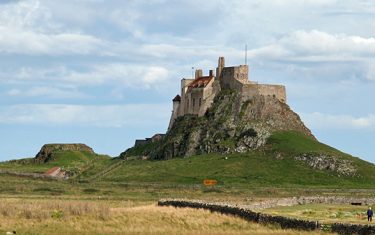 route from Melrose. The priory was built by early Christians over 1,400 years ago, raided by Vikings and restored in the 11th century.
route from Melrose. The priory was built by early Christians over 1,400 years ago, raided by Vikings and restored in the 11th century.
A unique feature of this walk is the dramatic causeway crossing to Holy Island, please check the tide times before planning your journey. There is an entry fee to visit the priory and museum, open daily from 10am to 6pm.

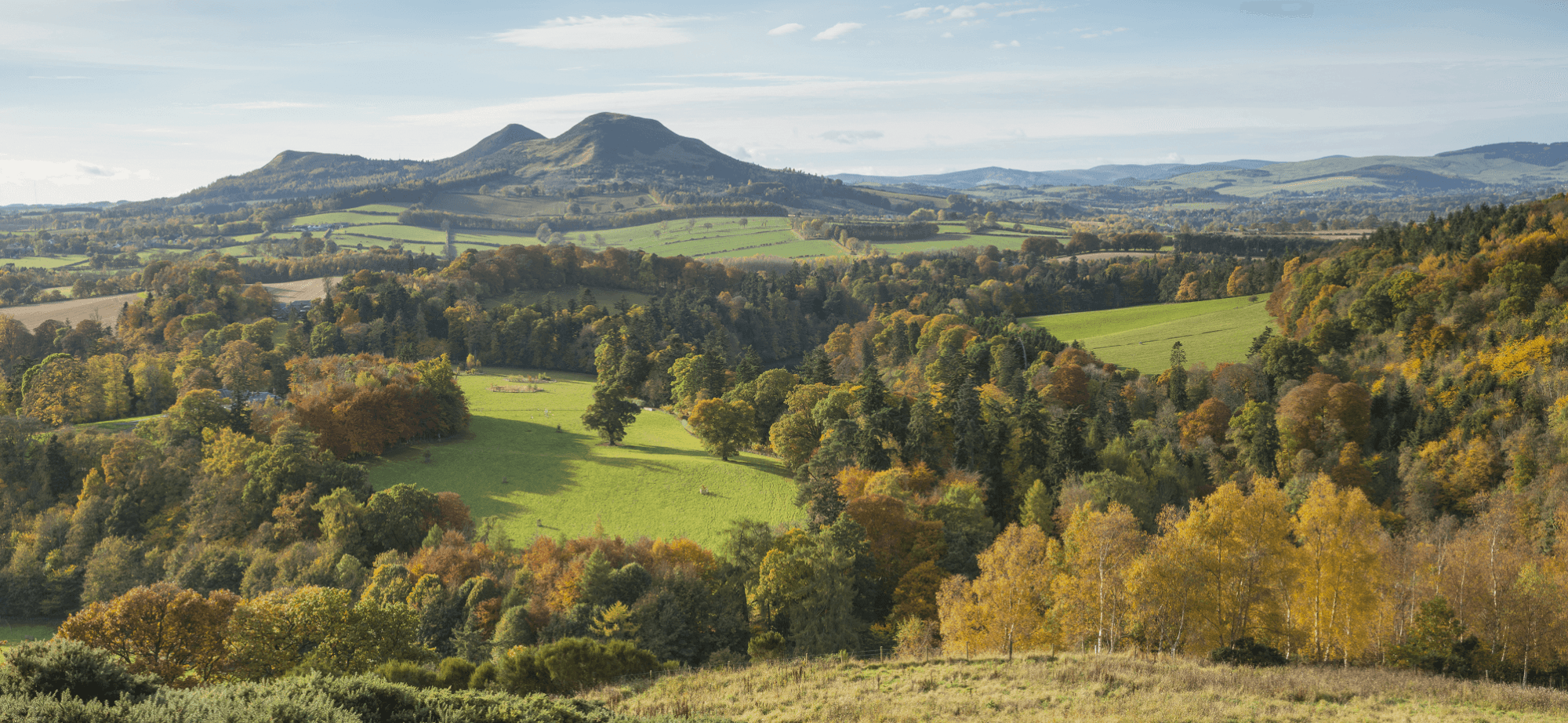

 Walk
Walk 
